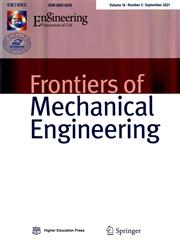倾斜胶体滴:蒸发动力学和模式形成
IF 4
2区 工程技术
Q1 ENGINEERING, MECHANICAL
引用次数: 1
摘要
在日常生活中,从油漆和打印机到窗户上干燥的雨滴,溶质液滴的干燥无处不在。尽管如此,科学界的兴趣主要集中在了解平面上的蒸发动力学,基质倾角这一关键参数直到最近才开始得到解决。这项工作的重点是在20°和40°适中的基质倾角对胶体滴蒸发动力学和相关沉积模式的影响。倾斜改变了液滴的形状,形成了液滴上部(后边缘)较小的接触角和下部(前缘)较大的接触角。由于蒸发速率是接触角的函数,而接触角又是倾角的函数,因此与平缓下降相比,20°和40°的蒸发寿命分别延长了43%和61%。通过液滴液-气界面蒸发通量的理论近似表明了每条边对蒸发动力学的贡献。这些蒸发通量的差异改变了液滴内部的流动,进而改变了咖啡环的形成机制。每个液滴的两个边缘的颗粒沉积形状是可视化的,结合理论论据允许在倾斜液滴中颗粒沉积机制的命题:倾斜增加了液滴中重力驱动的速度流分量,这是垂直的,因此在平坦的液滴中可以忽略不计。这种额外的流动分别阻碍或增加了到达倾斜液滴前后边缘的颗粒数量,从而影响了咖啡环图案的尺寸。最终,颗粒沉积物变得足够高,从而有效地阻止了向外流动,从而导致随着倾角的增加,颗粒在液滴内部的积聚增强。本文章由计算机程序翻译,如有差异,请以英文原文为准。
Inclined colloidal drops: Evaporation kinetics and pattern formation
The drying of solute-laden drops is ubiquitous in everyday life, from paints and printers to the raindrops drying on our windows. Nonetheless, scientific interest has primarily focused on understanding the evaporation kinetics on flat surface, with the key parameter of substrate inclination only recently started being addressed. This work focuses on the influence of moderate substrate inclinations at 20° and 40° on the evaporation kinetics and associated deposit patterns of colloidal drops. Inclination altered the shape of the drops which formed a lower contact angle at the upper side of the drop (rear edge) and larger contact angle at the lower side (front edge). As evaporation rate is a function of contact angle, which in turn is a function of inclination, the evaporation lifetime was extended by 43% and 61% for 20° and 40°, respectively, compared to a flat drop. A theoretical approximation of the evaporative flux across the liquid-vapour interface of the drops showed the contribution of each edge to the evaporation kinetics. These differences in the evaporative fluxes altered the internal flows within the drop and in turn the coffee-ring formation mechanism. The particle deposit shape at the two edges for each drop was visualised which combined with the theoretical arguments allowed the proposition of the particle deposition mechanism in inclined drops: inclination added a gravitationally-driven velocity flow component within the drops, which is perpendicular and hence negligible in flat drops. This additional flow hindered or enhanced the number of particles arriving at the rear and front edges of the inclined drops, respectively, and hence influenced the dimensions of the coffee-ring patterns. Eventually, the particle deposits grew sufficiently tall to effectively stagnate the outward flow which resulted in enhanced particle accumulation at the interior of the drops as inclination increased.
求助全文
通过发布文献求助,成功后即可免费获取论文全文。
去求助
来源期刊

Frontiers of Mechanical Engineering
Engineering-Mechanical Engineering
CiteScore
7.20
自引率
6.70%
发文量
731
期刊介绍:
Frontiers of Mechanical Engineering is an international peer-reviewed academic journal sponsored by the Ministry of Education of China. The journal seeks to provide a forum for a broad blend of high-quality academic papers in order to promote rapid communication and exchange between researchers, scientists, and engineers in the field of mechanical engineering. The journal publishes original research articles, review articles and feature articles.
 求助内容:
求助内容: 应助结果提醒方式:
应助结果提醒方式:


